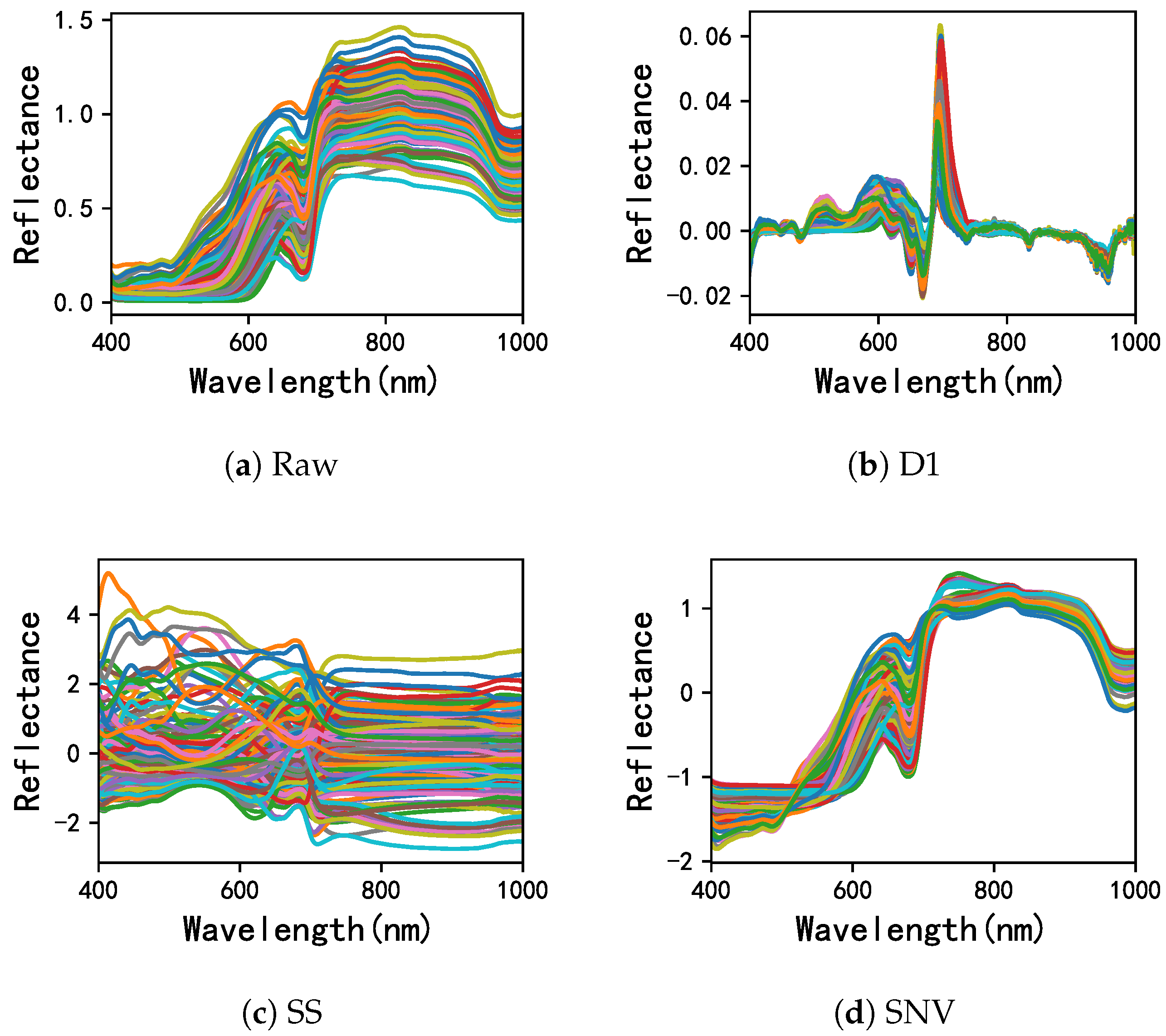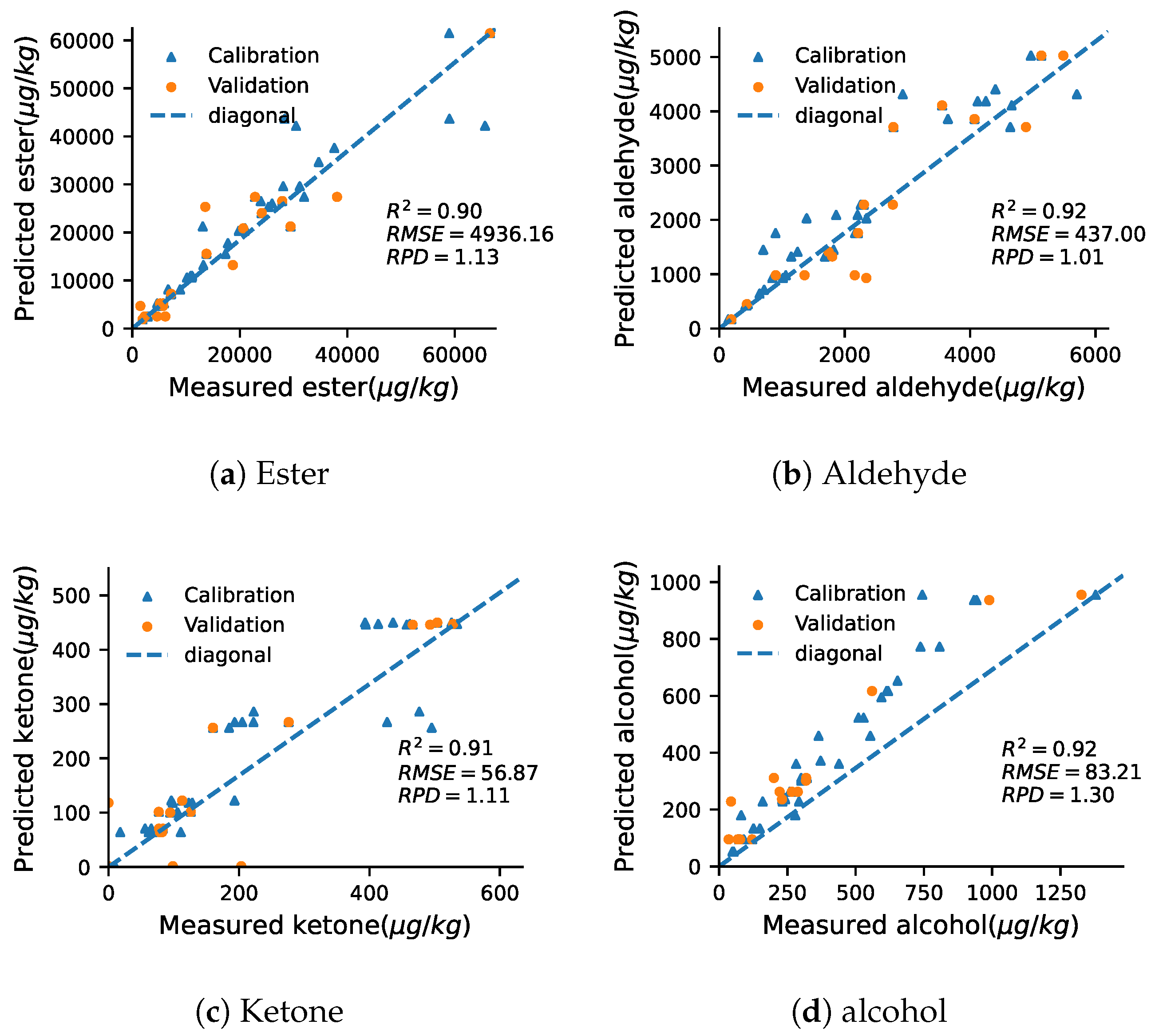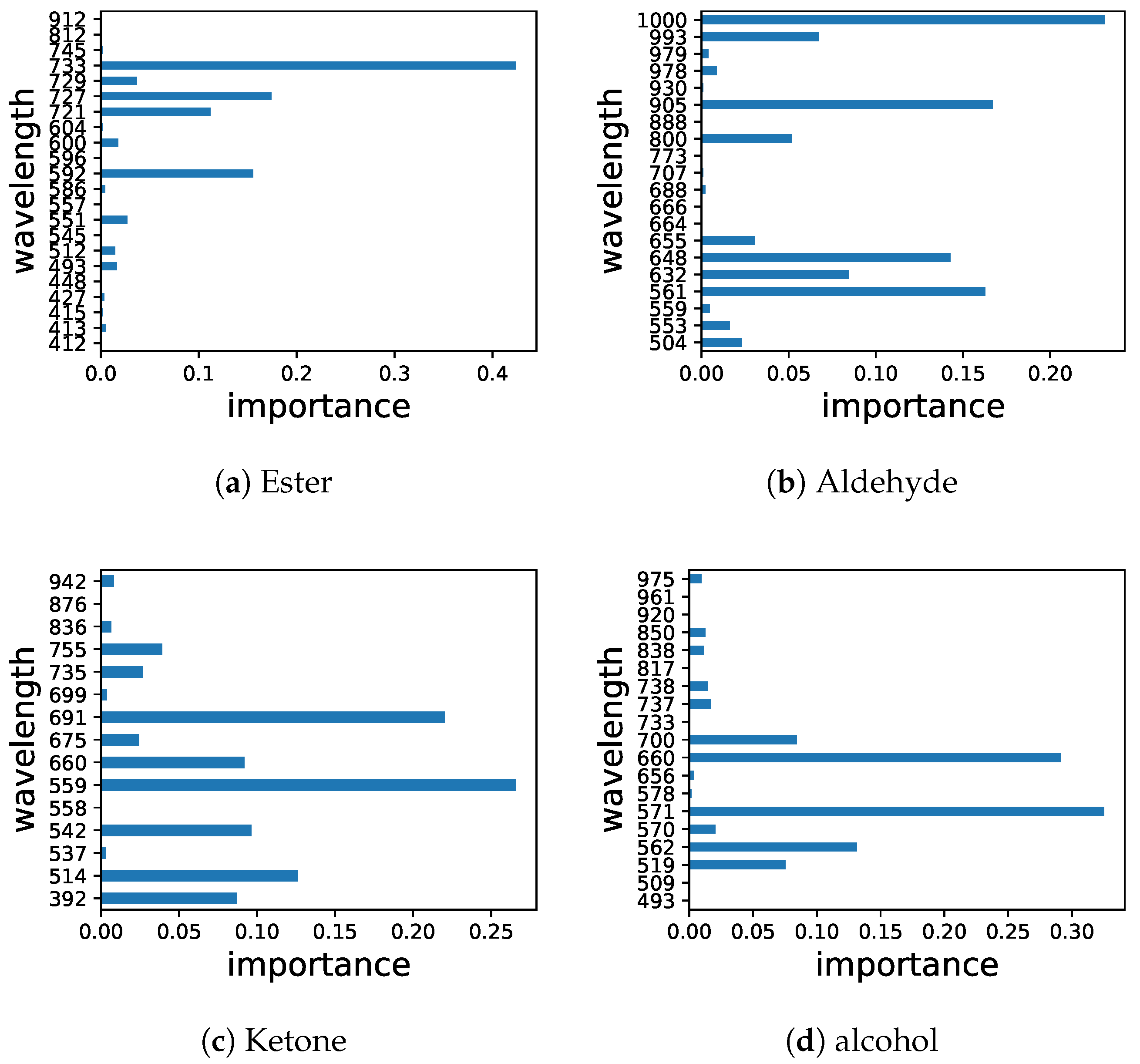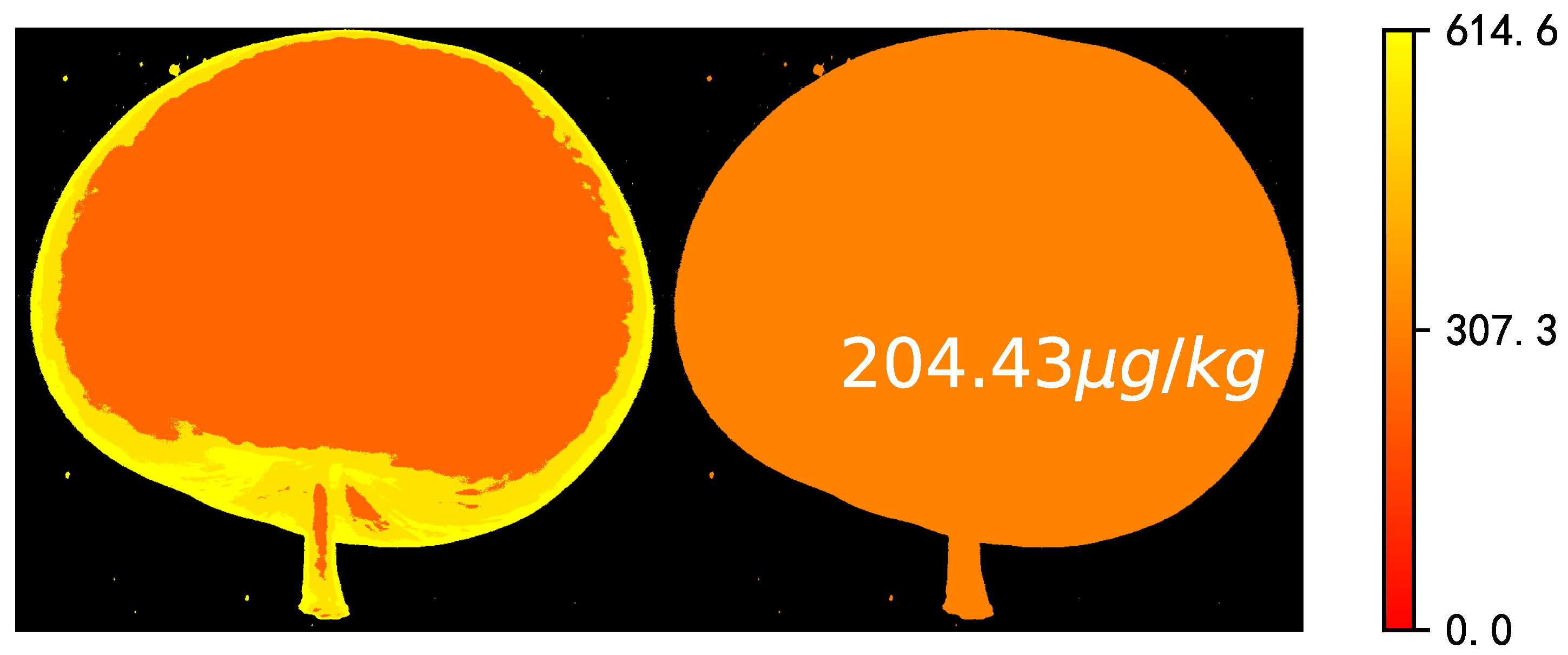Prediction of Apple Hybrid Offspring Aroma Based on Hyperspectral
Abstract
1. Introduction
2. Materials and Methods
2.1. Apples Fruit
2.2. Sample Preparation and Analysis of Volatile Aroma Compounds by GC-MS
2.3. Hyperspectral Imaging (HSI) System
2.4. Imaging Pre-Processing and Feature Wavelength Selection
2.5. Modelling
3. Results
3.1. Aroma Profile of Apples
3.2. Spectral Analysis and Preprocessing
3.3. Prediction of Chemical Groups of Apples
3.4. HSI Prediction of Single Volatile Compounds of Apple
3.5. Visualization of Apple Aroma Compounds
4. Conclusions
Author Contributions
Funding
Data Availability Statement
Acknowledgments
Conflicts of Interest
Appendix A
| Group | Name | Range | RMSEC | RMSEP | ||
|---|---|---|---|---|---|---|
| Ester | Ethyl acetate | 0–476.48 | 0.26 | 64.54 | 0.35 | 51.35 |
| Caprylic acid N-butyl ester | 0–2624.29 | 0.45 | 489.28 | 0.38 | 492.77 | |
| Isoamyl caprylate | 0–2089.09 | 0.27 | 257.51 | 0.24 | 326.93 | |
| Ethyl caprylate | 0–357.39 | 0.35 | 63.55 | 0.32 | 78.58 | |
| amyl octanoate | 0–558.61 | 0.38 | 87.46 | 0.33 | 85.19 | |
| Hexyl octanoate | 0–1713.13 | 0.35 | 88.13 | 0.22 | 145.53 | |
| Propyl octanoate | 0–271.70 | 0.42 | 52.05 | 0.27 | 58.62 | |
| Ethyl hexanoate | 0–549.01 | 0.3 | 79.62 | 0.49 | 66.87 | |
| Amyl caproate | 0–7495.30 | 0.4 | 445.13 | 0.23 | 608.85 | |
| Hexyl hexanoate | 0–47,995.00 | 0.34 | 3110.29 | 0.29 | 2881.89 | |
| Caproic acid propyl ester grade I | 0–750.94 | 0.54 | 120.2 | 0.5 | 108.79 | |
| Heptanoic acid, butylester | 0–361.20 | 0.55 | 54.07 | 0.48 | 51.93 | |
| Heptanoic acid isoamyl ester | 0–252.41 | 0.37 | 22.74 | 0.36 | 28.75 | |
| Butanoic acid, 3-methylbutyl ester | 0–860.87 | 0.48 | 83.68 | 0.43 | 79.37 | |
| Ethyl butyrate | 0–746.58 | 0.39 | 99.28 | 0.21 | 126.48 | |
| Amyl butyrate | 0–1126.70 | 0.49 | 64.79 | 0.32 | 79.24 | |
| n-butyl butyrate | 0–2600.97 | 0.38 | 425.38 | 0.25 | 401.32 | |
| n-Propyl propionate | 0–159.70 | 0.39 | 12.69 | 0.22 | 18.85 | |
| Isoamyl propionate | 0–166.31 | 0.44 | 25.84 | 0.36 | 33.59 | |
| Butyl Propionate | 0–1810.80 | 0.47 | 213.35 | 0.3 | 251.02 | |
| 2-Methyl Butyl Propionate | 0–570.28 | 0.43 | 93.13 | 0.28 | 107.16 | |
| Hexyl benzoate | 0–116.48 | 0.48 | 17.15 | 0.32 | 16.42 | |
| Butyl 2-methylbutyrate | 0–12,156.00 | 0.28 | 1342.21 | 0.34 | 1216.25 | |
| Butanoic acid,2-methyl-, 1-methylethyl ester | 0–464.43 | 0.29 | 86.04 | 0.23 | 96.6 | |
| 2-methylbutyl acetate | 47.22–10,913.10 | 0.36 | 790.66 | 0.37 | 693.59 | |
| 2-Pentanol propanoate | 0–308.83 | 0.22 | 36.15 | 0.31 | 30.45 | |
| Aldehyde | Octanal | 0–634.46 | 0.28 | 65.17 | 0.21 | 54.22 |
| Hexanal | 6.98–7989.12 | 0.37 | 873.76 | 0.24 | 1068.92 | |
| Nonanal | 0–990.50 | 0.32 | 157.76 | 0.34 | 172.58 | |
| Decanal | 0–881.03 | 0.4 | 37.45 | 0.36 | 51.24 | |
| Undecenal | 0–393.94 | 0.99 | 0.13 | 0.78 | 0.41 | |
| trans-2-Pentenal | 0–78.03 | 0.42 | 14.22 | 0.35 | 13.84 | |
| trans-2-Nonenal | 0–385.19 | 0.39 | 36.7 | 0.31 | 38.82 | |
| (E)-2-Octenal | 0–391.01 | 0.52 | 31.67 | 0.3 | 45.68 | |
| 5-Hydroxymethylfurfural | 0–18,504.71 | 0.39 | 525.55 | 0.31 | 506.01 | |
| (E)-2-tridecen-1-al | 0–24.19 | 0.8 | 2.19 | 0.6 | 2.44 | |
| 2-methylpent-4-enal | 0–857.36 | 0.5 | 107.39 | 0.35 | 85.57 | |
| Heptenal | 0–796.97 | 0.32 | 126.53 | 0.27 | 116.0 | |
| Ketone | 6-Methylhept-5-en-2-one | 0–432.67 | 0.41 | 79.07 | 0.21 | 97.56 |
| 6,10-Dimethyl-5,9-undecadien-2-one | 0–176.85 | 0.34 | 23.95 | 0.35 | 17.8 | |
| 1-Octen-3-one | 0–407.27 | 0.47 | 49.98 | 0.37 | 64.18 | |
| 1-Penten-3-one | 0–118.58 | 0.42 | 19.68 | 0.39 | 22.66 | |
| Alcohol | 1-Octanol | 0–88.82 | 0.42 | 13.75 | 0.24 | 14.47 |
| Ethanol | 0–420.63 | 0.24 | 68.25 | 0.26 | 62.02 | |
| Furfuryl alcohol | 0–2690.80 | 0.75 | 72.58 | 0.46 | 105.08 | |
| cyclooctanol | 0–170.87 | 0.94 | 6.05 | 0.9 | 8.58 | |
| trans-2-Hexen-1-ol | 0–191.16 | 0.36 | 42.9 | 0.23 | 40.01 | |
| 2-Methylbutan-1-ol | 0–3622.93 | 0.44 | 152.12 | 0.31 | 217.03 |
References
- Khan, M.A.; Olsen, K.M.; Sovero, V.; Kushad, M.M.; Korban, S.S. Fruit Quality Traits Have Played Critical Roles in Domestication of the Apple. Plant Genome 2014, 7, 1940–3372. [Google Scholar] [CrossRef]
- Nardini, G.S.; Merib, J.O.; Dias, A.N.; Dutra, J.N.; Silveira, C.D.; Budziak, D.; Carasek, E. Determination of volatile profile of citrus fruit by HS-SPME/GC-MS with oxidized NiTi fibers using two temperatures in the same extraction procedure. Microchem. J. 2013, 109, 128–133. [Google Scholar] [CrossRef]
- Lu, Y.; Saeys, W.; Kim, M.; Peng, Y.; Lu, R. Hyperspectral imaging technology for quality and safety evaluation of horticultural products: A review and celebration of the past 20-year progress. Postharvest Biol. Technol. 2020, 170, 0925–5214. [Google Scholar] [CrossRef]
- Siche, R.; Vejarano, R.; Aredo, V.; Velasquez, L.; Saldana, E.; Quevedo, R. Evaluation of Food Quality and Safety with Hyperspectral Imaging (HSI). Food Eng. Rev. 2016, 8, 4306–4322. [Google Scholar] [CrossRef]
- Mollazade, K.; Omid, M.; Tab, F.A.; Mohtasebi, S.S. Principles and Applications of Light Backscattering Imaging in Quality Evaluation of Agro-food Products: A Review. Food Bioprocess Technol. 2012, 5, 1465–1485. [Google Scholar] [CrossRef]
- Mendoza, F.; Lu, R.; Ariana, D.; Cen, H.; Bailey, B. Integrated spectral and image analysis of hyperspectral scattering data for prediction of apple fruit firmness and soluble solids content. Postharvest Biol. Technol. 2011, 62, 149–160. [Google Scholar] [CrossRef]
- Ding, C.; Feng, Z.; Wang, D.; Cui, D.; Li, W. Acoustic vibration technology: Toward a promising fruit quality detection method. Compr. Rev. Food Sci. Food Saf. 2021, 20, 1655–1680. [Google Scholar] [CrossRef] [PubMed]
- Feng, Z. Clamping Device for Detection of Moldy Core in Apples. Master’s Thesis, Northwest Agricultural & Forestry University, Shaanxi, China, 2017. [Google Scholar]
- Ma, T.; Xia, Y.; Inagaki, T.; Tsuchikawa, S. Non-destructive and fast method of mapping the distribution of the soluble solids content and pH in kiwifruit using object rotation near-infrared hyperspectral imaging approach. Postharvest Biol. Technol. 2021, 174, 111440. [Google Scholar] [CrossRef]
- Chu, X.; Miao, P.; Zhang, K.; Wei, H.; Fu, H.; Liu, H.; Ma, Z. Green Banana Maturity Classification and Quality Evaluation Using Hyperspectral Imaging. Agriculture 2022, 12, 530. [Google Scholar] [CrossRef]
- Fan, Z.; Wang, D.; Zhang, N.; Zhou, B. Monitoring of Nitrogen Transport in Pear Trees Based on Ground Hyperspectral Remote Sensing and Digital Image Information. J. Chem. 2022, 2022, 7590846. [Google Scholar] [CrossRef]
- Chen, X.; Yi, H.; Wang, N.; Zhang, M.; Jiang, S.; Xu, J.; Mao, Z.; Zhang, Z.; Wang, Z.; Jiang, Z.; et al. The selection of bud varieties promotes the high-quality and efficient development of the world’s apple and citrus industries. Chin. Agric. Sci. 2022, 55, 755–768. [Google Scholar]
- Klee, H.J. Improving the flavor of fresh fruits: Genomics, biochemistry, and biotechnology. New Phytol. 2010, 187, 44–56. [Google Scholar] [CrossRef] [PubMed]
- Su, W.H.; Sun, D.W.; He, J.G.; Zhang, L.B. Variation analysis in spectral indices of volatile chlorpyrifos and non-volatile imidacloprid in jujube (Ziziphus jujuba Mill.) using near-infrared hyperspectral imaging (NIR-HSI) and gas chromatograph-mass spectrometry (GC–MS). Food Res. Int. 2018, 108, 628–640. [Google Scholar] [CrossRef]
- Caporaso, N.; Whitworth, M.B.; Cui, C.; Fisk, I.D. Variability of single bean coffee volatile compounds of Arabica and robusta roasted coffees analysed by SPME-GC-MS. Comput. Electron. Agric. 2017, 139, 41–55. [Google Scholar] [CrossRef] [PubMed]
- Jin, X.; Liu, L.; Liu, Y.; Guo, Y.; Mao, D. Hyperspectral imaging technology for non-destructive testing of grape aroma components at different ripening stages. Food Ind. 2020, 11, 324–328. [Google Scholar]
- Aprea, E.; Gika, H.; Carlin, S.; Theodoridis, G.; Vrhovsek, U.; Mattivi, F. Metabolite profiling on apple volatile content based on solid phase microextraction and gas-chromatography time of flight mass spectrometry. J. Chromatogr. A 2011, 1218, 4517–4524. [Google Scholar] [CrossRef]
- Yan, D.; Shi, J.; Ren, X.; Tao, Y.; Ma, F.; Li, R.; Liu, C. Insights into the aroma profiles and characteristic aroma of ‘Honeycrisp’ apple (Malus × domestica). Food Chem. 2020, 327, 127074. [Google Scholar] [CrossRef]
- Wu, X.; Bi, J.; Fauconnier, M.L. Characteristic Volatiles and Cultivar Classification in 35 Apple Varieties: A Case Study of Two Harvest Years. Foods 2022, 11, 690. [Google Scholar] [CrossRef]
- Ci, Z.; Tian, L.; Liu, X.; Mou, H.; Song, L. Research progress on the aromatic substance of Fuji apple. Chin. Fruit Trees 2022, 3, 1–5. [Google Scholar]
- Shao, Y.; Wang, K.; Xuan, G.; Gao, C.; Hu, Z. Soluble solids content monitoring for shelf-life assessment of table grapes coated with chitosan using hyperspectral imaging. Infrared Phys. Technol. 2021, 115, 103725. [Google Scholar] [CrossRef]
- Mo, C.; Kim, M.S.; Kim, G.; Lim, J.; Delwiche, S.R.; Chao, K.; Cho, B.K. Spatial assessment of soluble solid contents on apple slices using hyperspectral imaging. Biosyst. Eng. 2017, 159, 10–21. [Google Scholar] [CrossRef]
- Ignat, T.; Lurie, S.; Nyasordzi, J.; Ostrovsky, V.; Egozi, H.; Hoffman, A.; Schmilovitch, Z.E. Forecast of Apple Internal Quality Indices at Harvest and During Storage by VIS-NIR Spectroscopy. Food Bioprocess Technol. 2014, 7, 2951–2961. [Google Scholar] [CrossRef]
- Yuan, X. Research on Nondestructive Detection System of Apple Suger Content Based on Hyperspectral Imaging Technology. Master’s Thesis, Northwest Agricultural & Forestry University, Shaanxi, China, 2021. [Google Scholar]
- Keresztes, J.C.; Goodarzi, M.; Saeys, W. Real-time pixel based early apple bruise detection using short wave infrared hyperspectral imaging in combination with calibration and glare correction techniques. J. Spectrosc. 2016, 66, 215–226. [Google Scholar] [CrossRef]
- Zhu, X.; Li, G. Rapid detection and visualization of slight bruise on apples using hyperspectral imaging. Int. J. Food Prop. 2019, 22, 1709–1719. [Google Scholar] [CrossRef]
- Ncama, K.; Opara, U.L.; Tesfay, S.Z.; Fawole, O.A.; Magwaza, L.S. Application of Vis/NIR spectroscopy for predicting sweetness and flavour parameters of ‘Valencia’ orange (Citrus sinensis) and ‘Star Ruby’ grapefruit (Citrus x paradisi Macfad). J. Food Eng. 2017, 193, 86–94. [Google Scholar] [CrossRef]
- Jiang, X.; Zhu, M.; Yao, J.; Zhang, Y.; Liu, Y. Study on the Effect of Apple Size Difference on Soluble Solids Content Model Based on Near-Infrared (NIR) Spectroscopy. J. Spectrosc. 2022, 2022, e3740527. [Google Scholar] [CrossRef]
- Xuan, G.; Gao, C.; Shao, Y. Spectral and image analysis of hyperspectral data for internal and external quality assessment of peach fruit. Spectrochim. Acta. Part A Mol. Biomol. Spectrosc. 2022, 272, 121016. [Google Scholar] [CrossRef] [PubMed]





| Group | Range | Method | RMSEC | RMSEP | RPD | ||
|---|---|---|---|---|---|---|---|
| Ester | 1286.91–15,432.56 | raw | 0.84 | 7042.37 | 0.81 | 7273.12 | 1.04 |
| SNV | 0.9 | 4936.16 | 0.9 | 4759.18 | 1.13 | ||
| SS | 0.83 | 6513.77 | 0.83 | 6678.67 | 1.12 | ||
| D1 | 0.82 | 6562.55 | 0.86 | 5996.54 | 1.43 | ||
| Aldehyde | 173.85–12,635.05 | raw | 0.79 | 696.53 | 0.75 | 805.28 | 1.28 |
| SNV | 0.92 | 437 | 0.84 | 649.23 | 1.01 | ||
| SS | 0.88 | 517.1 | 0.81 | 702.78 | 1.25 | ||
| D1 | 0.83 | 648.6 | 0.82 | 615.31 | 1.11 | ||
| Ketone | 13.02–655.99 | raw | 0.88 | 57.04 | 0.83 | 75.17 | 1.10 |
| SNV | 0.91 | 56.87 | 0.86 | 59.52 | 1.11 | ||
| SS | 0.82 | 73.98 | 0.8 | 74.88 | 1.16 | ||
| D1 | 0.83 | 71.57 | 0.86 | 60.75 | 1.13 | ||
| Alcohol | 33.77–1504.67 | raw | 0.89 | 115.95 | 0.84 | 99.6 | 0.93 |
| SNV | 0.92 | 83.21 | 0.91 | 112.09 | 1.30 | ||
| SS | 0.87 | 103.1 | 0.86 | 100.28 | 0.93 | ||
| D1 | 0.83 | 125.17 | 0.76 | 148.38 | 1.14 |
Publisher’s Note: MDPI stays neutral with regard to jurisdictional claims in published maps and institutional affiliations. |
© 2022 by the authors. Licensee MDPI, Basel, Switzerland. This article is an open access article distributed under the terms and conditions of the Creative Commons Attribution (CC BY) license (https://creativecommons.org/licenses/by/4.0/).
Share and Cite
Zhu, H.; Wang, M.; Zhang, J.; Ma, F. Prediction of Apple Hybrid Offspring Aroma Based on Hyperspectral. Foods 2022, 11, 3890. https://doi.org/10.3390/foods11233890
Zhu H, Wang M, Zhang J, Ma F. Prediction of Apple Hybrid Offspring Aroma Based on Hyperspectral. Foods. 2022; 11(23):3890. https://doi.org/10.3390/foods11233890
Chicago/Turabian StyleZhu, Huili, Minyan Wang, Jing Zhang, and Fengwang Ma. 2022. "Prediction of Apple Hybrid Offspring Aroma Based on Hyperspectral" Foods 11, no. 23: 3890. https://doi.org/10.3390/foods11233890
APA StyleZhu, H., Wang, M., Zhang, J., & Ma, F. (2022). Prediction of Apple Hybrid Offspring Aroma Based on Hyperspectral. Foods, 11(23), 3890. https://doi.org/10.3390/foods11233890





